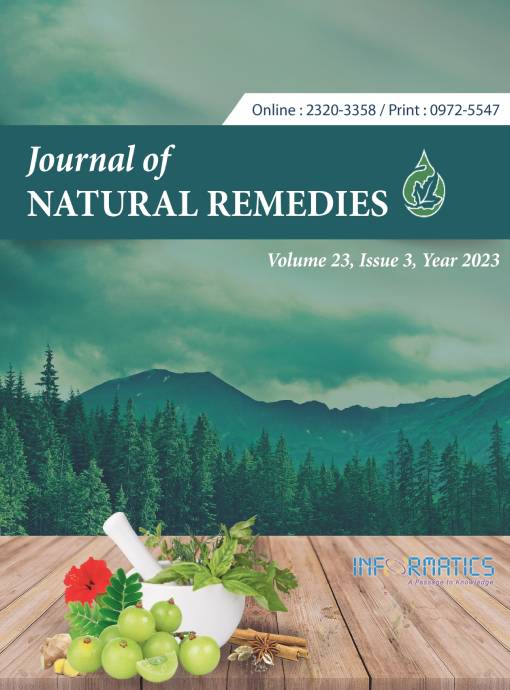Computational Analysis Depicting Potency of Phytochemicals to Target MAPK Signalling Pathway in Breast Cancer
DOI:
https://doi.org/10.18311/jnr/2023/31321Keywords:
MAPK, MD Simulation, Molecular Docking, PhytochemicalsAbstract
Background: Breast cancer has caused significant mortality among women worldwide. A comprehensive analysis of the disease indicated that MAPK signalling pathways are primarily involved in cell proliferation and have substantially induced drug resistance amongst the diseased individuals and henceforth may be considered a potential drug target to combat the disease. Methods: Phytochemicals obtained from medicinal plants were evaluated for their efficacy to target MAPK by molecular docking and were compared with synthetic analogues available in the market to target the disease. The stability of complexes was determined using MD Simulation, and interaction energy was calculated. Ligand binding pockets of interaction were also depicted along with the computation of RMSD. Results: Withanolide belonging to Withania somnifera exhibited the highest BA at both 35 × 57 × 38 Å and 33 × 41 × 41 Å sites of MAPK. Withanolide showed a BA of -10.2 Kcal/mol in comparison to AL8697 and Ralimetinib mesylate, which represented BA of -8.5 and -8.0 Kcal/mol, respectively. The Withanolide- MAPK complex showed stable conformation during MD Simulation. RMSD value for Withanolide was found to be the least, thereby indicating the least fluctuations during the interactions. Conclusion: The present study unveiled that Withanolide may emerge as a potential drug candidate to target MAPK signalling pathway in breast cancer.
Downloads
Metrics
Downloads
Published
How to Cite
Issue
Section
License
Copyright (c) 2022 Acharya Balkrishna, Sagar Kumar, Purushottam Hazari, Rashmi Sahu, Vedpriya Arya (Author)

This work is licensed under a Creative Commons Attribution 4.0 International License.
Accepted 2023-03-29
Published 2023-07-03
References
Lu H, Guo Y, Gupta G, Tian X. Mitogen- Activated Protein Kinase (MAPK): New insights in breast cancer. J Environ Pathol Toxicol Oncol. 2019; 38(1). https://doi.org/10.1615/JEnvironPatholToxicolOncol.2018028386 DOI: https://doi.org/10.1615/JEnvironPatholToxicolOncol.2018028386
Mittal R, Chaudhry N, Pathania S, Mukherjee TK. Mechanistic insight of drug resistance with special focus on iron in estrogen receptor positive breast cancer. Curr Pharm Biotechnol. 2014; 15(12):1141- 57. DOI: https://doi.org/10.2174/1389201015666141126121240
Guo YJ, Pan WW, Liu SB, Shen ZF, Xu Y, Hu LL. ERK/MAPK signalling pathway and tumorigenesis. Exp Ther Med. 2020; 19(3):1997-2007. https://doi. org/10.3892/etm.2020.8454 DOI: https://doi.org/10.3892/etm.2020.8454
Arora B, Chaudhry N, Mittal R. Effects of varying environment on production of biologically active compounds in neem. Bio-Chemiae Acta. 2016; 1:106- 13.
Mittal R, Chaudhry N, Mukherjee TK. Targeting breast cancer cell signaling molecules PI3K and Akt by phytochemicals Cannabidiol, Nimbin and Acetogenin: An in-silico approach. J Biomed. 2018; 3:60-3. https://doi.org/10.7150/jbm.25815 DOI: https://doi.org/10.7150/jbm.25815
Lee S, Rauch J, Kolch W. Targeting MAPK signaling in cancer: Mechanisms of drug resistance and sensitivity. Int J Mol Sci. 2020; 21(3). https://doi. org/10.3390/ijms21031102 DOI: https://doi.org/10.3390/ijms21031102
Chirumbolo S, Bjørklund G, Lysiuk R, Vella A, Lenchyk L, Upyr T. Targeting cancer with phytochemicals via their fine tuning of the cell survival signaling pathways. Int J Mol Sci. 2018; 19(11). https://doi.org/10.3390/ijms19113568 DOI: https://doi.org/10.3390/ijms19113568
Pubchem: National Library of Medicine (n.d.). Available at: https://pubchem.ncbi.nlm.nih.gov/
Koeberle SC, Romir J, Fischer S, KoeberleA, Schattel V, Albrecht W, et al. Skepinone-L is a selective p38 mitogen-activated protein kinase inhibitor. Nat Chem Biol. 2012; 8(2):141-3. https://doi.org/10.1038/ nchembio.761 DOI: https://doi.org/10.1038/nchembio.761
Balkrishna A, Mittal R, Arya V. Unveiling novel therapeutic drug targets and prognostic markers of triple negative breast cancer. Curr Cancer Drug Targets. 2021; 21(11):907-18. https://doi.org/10.2174 /1568009621666210908113010 DOI: https://doi.org/10.2174/1568009621666210908113010
Ferreira LG, Dos Santos RN, Oliva G, Andricopulo AD. Molecular docking and structure-based drug design strategies. Molecules. 2015; 20(7):13384-421. https://doi.org/10.3390/molecules200713384 DOI: https://doi.org/10.3390/molecules200713384
Morris GM, Huey R, Lindstrom W, Sanner MF, Belew RK, Goodsell DS, Olson AJ. AutoDock4 and AutoDockTools4: Automated docking with selective receptor flexibility. J Comput Chem. 2009; 30(16):2785-91. https://doi.org/10.1002/jcc.21256 DOI: https://doi.org/10.1002/jcc.21256
Balkrishna A, Mittal R, Sharma G, Arya V. Computational insights of phytochemical-driven disruption of RNA-dependent RNA polymerasemediated replication of coronavirus: A strategic treatment plan against coronavirus disease 2019. New Microbes New Infect. 2021; 41. https://doi. org/10.1016/j.nmni.2021.100878 DOI: https://doi.org/10.1016/j.nmni.2021.100878
Balkrishna A, Mittal R, Arya V. Computational evidences of phytochemical mediated disruption of PLpro driven replication of SARS-CoV-2: A therapeutic approach against COVID-19. Curr Pharm Biotechnol. 2021; 22(10):1350-9. https://doi.org/10.2174/1389201021999201110204116 DOI: https://doi.org/10.2174/1389201021999201110204116

 Acharya Balkrishna
Acharya Balkrishna









 0.35
0.35 24
24 0.161
0.161